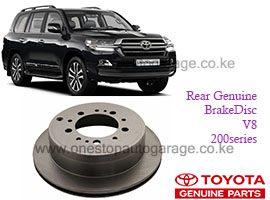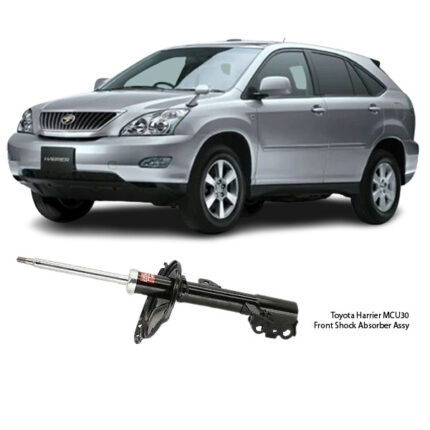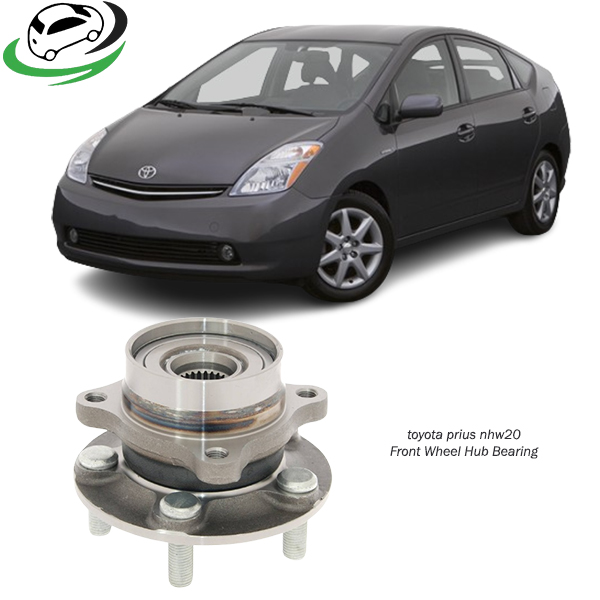-6%
Get Toyota Prius Hybrid NHW20 Front Wheel Hub Bearing 43510-47012
The front wheel hub bearing is a crucial component of a vehicle’s wheel assembly, responsible for allowing the wheel to rotate smoothly with minimal friction. Located within the hub assembly, it plays an essential role in supporting the vehicle’s weight, maintaining wheel alignment, and enhancing driving stability. This part is fundamental to ensuring a smooth, safe, and controlled driving experience. Understanding the construction, functions, benefits, symptoms of wear, and maintenance tips for a front wheel hub bearing can help improve vehicle longevity and safety.
1. Overview of the Front Wheel Hub Bearing
The front wheel hub bearing is housed within the hub assembly, which connects the wheel to the vehicle’s suspension and steering systems. A vehicle’s wheels rely on these bearings to rotate smoothly on the axle, reducing friction and wear. The design of a wheel hub bearing combines the hub and bearing elements, allowing it to handle radial and axial loads, such as acceleration, braking, and cornering forces.
There are two primary types of wheel bearings used in vehicles:
- Ball Bearings: These are versatile and can handle both radial and axial loads well. Ball bearings are commonly used in passenger cars.
- Roller Bearings: These are more suitable for heavy vehicles like trucks, as they can handle heavier loads but primarily in the radial direction.
Wheel hub bearings are generally designed to be a sealed unit, which protects the inner components from contamination by dirt, debris, and water, reducing the need for frequent maintenance.
2. Functions of the Front Wheel Hub Bearing
The front wheel hub bearing performs multiple essential functions:
- Supports the Vehicle’s Weight: The bearing holds the weight of the vehicle on each wheel, supporting the vehicle’s weight distribution and stability.
- Allows Smooth Wheel Rotation: Bearings enable the wheels to rotate with minimal friction, which is critical for smooth driving and handling.
- Reduces Friction and Heat: By minimizing contact between moving parts, the bearing reduces friction and helps prevent heat buildup in the wheel assembly.
- Improves Driving Stability and Safety: A well-functioning hub bearing ensures that the wheels maintain proper alignment and stability, which is essential for safe handling and braking.
- Supports Steering and Suspension: The bearing plays a role in connecting the wheel hub to the steering and suspension systems, which allows for precise control and response to road conditions.
3. Construction and Design of the Front Wheel Hub Bearing
The typical front wheel hub bearing assembly includes several key components:
- Inner and Outer Rings (Races): These rings house the rolling elements and provide a track for them to rotate. The inner race is attached to the hub, while the outer race is pressed into the wheel hub assembly.
- Rolling Elements (Ball or Roller Bearings): These are located between the inner and outer rings and help to reduce friction as the wheel rotates. Ball bearings are often used in light-duty vehicles, while heavier vehicles may utilize roller bearings for added strength.
- Seals: The wheel bearing assembly includes seals that prevent dirt, dust, and water from contaminating the bearing’s interior, which could lead to corrosion and premature wear.
- Grease: The sealed bearings contain grease that acts as a lubricant, allowing the rolling elements to move smoothly within the bearing assembly without wearing out.
Front wheel hub bearings are designed to be compact and durable, as they handle a substantial amount of load while withstanding extreme conditions.
4. Benefits of a High-Quality Front Wheel Hub Bearing
A high-quality front wheel hub bearing offers several benefits:
- Enhanced Driving Safety: A reliable bearing contributes to stability during cornering, braking, and acceleration, making the vehicle safer to drive.
- Improved Fuel Efficiency: Efficient bearings reduce friction, which helps improve fuel economy by requiring less power to rotate the wheels.
- Extended Tire Life: A well-functioning bearing maintains the wheel alignment, reducing uneven tire wear and prolonging the lifespan of the tires.
- Reduced Maintenance Costs: Quality bearings are generally designed to be maintenance-free, reducing the need for lubrication or frequent inspections.
- Smoother Ride: Bearings reduce vibrations and noise, leading to a quieter, more comfortable ride.
5. Signs of a Worn or Failing Front Wheel Hub Bearing
While wheel hub bearings are designed to last, they can still wear out over time, especially under harsh driving conditions. Here are common symptoms of a failing wheel hub bearing:
- Grinding or Growling Noises: One of the most common indicators of a failing wheel bearing is a grinding or growling noise, especially noticeable at higher speeds or during cornering.
- Vibration in the Steering Wheel: A worn bearing can cause vibration or wobbling in the steering wheel, especially when driving at higher speeds.
- Uneven Tire Wear: If the bearing wears out, it can lead to misalignment, causing the tires to wear unevenly or prematurely.
- Pulling to One Side: A worn bearing can cause the vehicle to pull to one side, as the wheel alignment may be affected by the bearing’s condition.
- Loose Wheels: When the bearing wears out, it may cause the wheel to become loose, affecting stability and making the vehicle unsafe to drive.
Early detection of a failing bearing can prevent further damage to the suspension and steering components, reducing the need for extensive repairs.
6. Causes of Front Wheel Hub Bearing Wear and Failure
Several factors can contribute to the premature wear of a front wheel hub bearing:
- Exposure to Harsh Elements: Dirt, dust, water, and road salt can cause the bearing to corrode or wear out faster.
- Excessive Load or Impact: Bearing failure can result from impacts, such as hitting a pothole or curb, or from carrying heavy loads that exceed the vehicle’s design limits.
- Improper Installation: Incorrect installation can lead to misalignment, putting additional stress on the bearing and causing it to wear out faster.
- Driving Habits: Aggressive driving, sudden stops, and high-speed cornering can increase stress on the wheel bearings, causing them to wear out more quickly.
- Age and Mileage: Like all mechanical components, wheel bearings have a finite lifespan and will eventually need replacement, especially in high-mileage vehicles.
7. Maintenance and Replacement of the Front Wheel Hub Bearing
Most modern wheel hub bearings are sealed units and do not require regular maintenance. However, certain steps can extend their lifespan and improve performance:
- Regular Inspections: Periodic inspection of the wheel bearings can help detect early signs of wear, such as noises or loose play in the wheel.
- Avoid Overloading: Avoid carrying loads that exceed the vehicle’s capacity, as this can put excess strain on the wheel bearings.
- Safe Driving Practices: Driving carefully and avoiding harsh impacts, such as potholes or curbs, can help protect the bearings from unnecessary wear.
- Timely Replacement: When a wheel bearing shows signs of wear, it’s essential to replace it promptly to prevent damage to other suspension components.
Replacement Process
Replacing a front wheel hub bearing requires specialized tools and is usually best performed by a professional. The process generally involves:
- Removing the Wheel and Brake Components: The wheel and brake caliper are removed to access the hub assembly.
- Removing the Hub Assembly: The hub assembly is removed from the steering knuckle, often requiring a press to separate the bearing from the assembly.
- Installing the New Bearing: A new bearing is pressed into the hub assembly, and the assembly is reattached to the steering knuckle.
- Reassembly: The brake components and wheel are reinstalled, and the vehicle’s alignment may need adjustment afterward.
8. When to Replace a Front Wheel Hub Bearing
Wheel hub bearings are generally durable and designed to last between 80,000 and 120,000 miles, depending on driving conditions. However, replacement may be necessary sooner if any of the following occurs:
- Persistent noise that worsens over time.
- Play or looseness in the wheel.
- Wobbling or uneven tire wear.
- Increased steering effort.
Prompt replacement of a failing bearing can help avoid more extensive repairs, such as replacing damaged suspension or steering components.
9. Conclusion
The front wheel hub bearing is a key component of a vehicle’s wheel assembly, ensuring smooth rotation and providing essential support to the vehicle’s suspension and steering systems. By maintaining stability and reducing friction, a well-functioning wheel bearing enhances driving safety, ride comfort, and fuel efficiency. Recognizing the signs of a failing bearing and understanding proper maintenance practices can help maximize its lifespan and ensure a reliable, enjoyable driving experience.
Follow us on Facebook for more parts.





